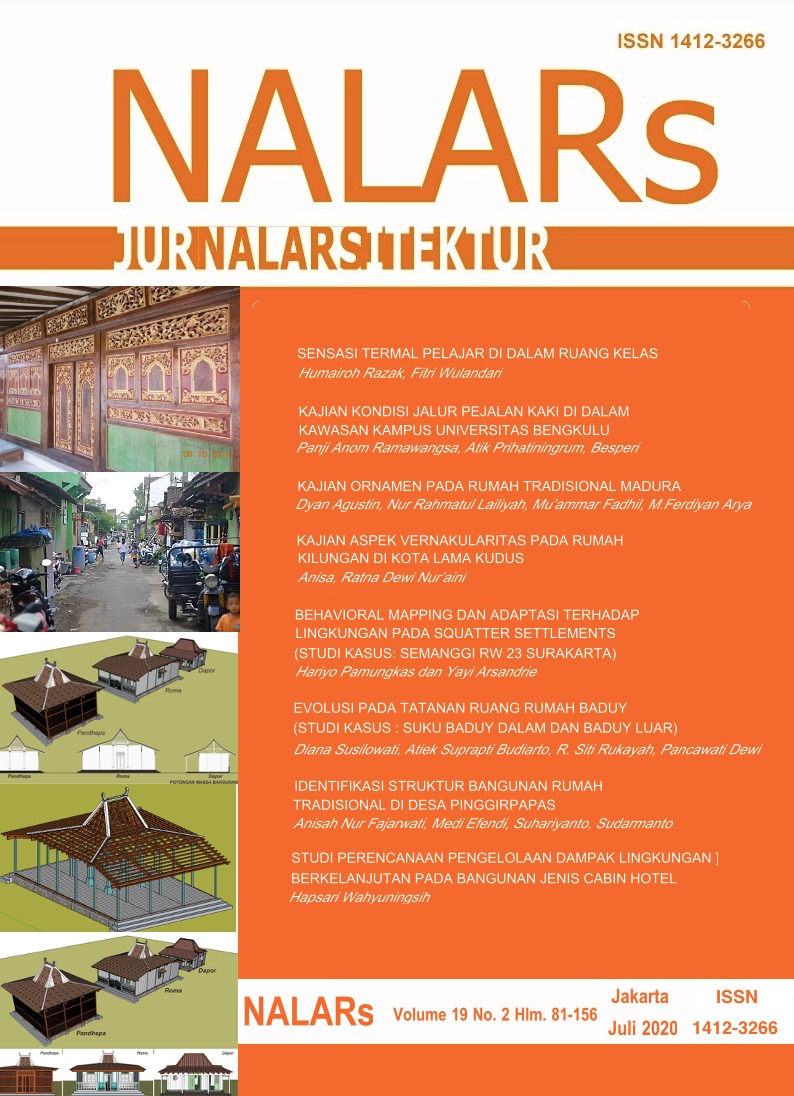Sensasi Termal Pelajar di Dalam Ruang Kelas
DOI:
https://doi.org/10.24853/nalars.19.2.81-88Abstract
ABSTRAK. Kota Banjarmasin memiliki iklim tropis lembab, kenyamanan termal menjadi unsur kenyamanan yang vital untuk dicapai khususnya untuk efektifitas kegiatan belajar bagi pelajar. Terutama dengan terjadinya pemanasan global, penggunaan penghawaan buatan seperti Air Conditioning (AC) justru akan memperparah terjadinya climate change karena AC merupakan salah satu sumber utama penghasil emisi. Metode pelaksaan penelitian ini dengan menggabungkan metode kuantitatif dan kualitatif. Metode kuantitatif digunakan untuk mengetahui kondisi termal di dalam dan di luar ruang kelas dengan mencari temperatur efektif kondisi termal di dalam ruang kelas dan kondisi iklim lingkungan sekolah dengan menggunakan alat environmental meter. Sedangkan metode kualitatif untuk mengetahui sensasi termal yang dirasakan pelajar saat berada di dalam ruang kelas, pengambilan data dilakukan 3 kali dengan interval 2 jam dimulai pukul 08.00 WITA. Hasil penelitian menunjukan bahwa sensasi termal yang dirasakan oleh pelajar pada pukul 08.00 dan pukul 10.00 WITA kurang dari 30% yang merasa nyaman saat berada di dalam ruang kelas dan tersisa hanya 5.14% pelajar yang merasa nyaman pada pukul 12.00 WITA. Puncaknya pada pukul 12.00 WITA saat matahari berada persis di puncak tertinggi 93.15% pelajar merasakan kepanasan, yaitu terasa agak panas, panas dan panas sekali. Hal ini didukung dengan data kuantitatif yang temperatur efektif di dalam ruang kelas berada di atas batas kenyamanan Webb, yaitu 30.58°C TE pada pukul 08.00 WITA, meningkat menjadi 31.38°C TE pada pukul 10.00 WITA dan puncak tertinggi pada pukul 12.00 WITA mencapai 31.57°C TE. Kata kunci: Kenyamanan Termal, Temperatur Efektif, Lubang Udara, Ruang Kelas, Ventilasi Silang ABSTRACT. Banjarmasin city has a humid tropical climate, which makes thermal comfort one of the vital comfort elements to be achieved. Especially for the effectiveness of the students' learning activities. Global warming is a hot topic today; the use of artificial ventilation such as air conditioning (AC) will aggravate climate change. AC is one of the primary sources of global emission. This research used both quantitative and qualitative methods. The quantitative approach is used to determine thermal conditions inside and outside the classroom by finding the classroom's effective temperature and school environment using environmental meter tools. On the other hand, the qualitative method is used to determine student's thermal sensations inside the classroom. Data collection was carried out three times in 2-hour intervals starting at 08.00 WITA. The results showed that the students' thermal feeling inside the classroom at 8:00, and 10:00 WITA was less than 30% who felt comfortable while only 5.14% felt comfortable at 12.00 WITA. The peak is at 12.00 WITA when the sun is precisely at the highest peak, 93.15 % of students feel discomfort, which is feeling rather hot, hot, and very hot. This is supported by quantitative data where the effective temperature in the classroom is over Webb's comfort limit, which is 30.58 ° C ET at 08.00 WITA, increasing to 31.38 ° C at 10:00 WITA and the highest peak at 12.00 WITA reaching 31.57 ° C ET. Keywords: Thermal Comfort, Effective Temperature, Air Opening, Classroom, Cross VentilationDownloads
Published
2020-06-29
Issue
Section
Articles


